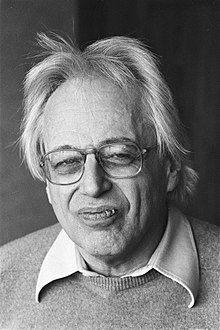Trio for Violin, Horn and Piano (Ligeti)
| Trio for Violin, Horn and Piano | |
|---|---|
| Hommage à Brahms | |
| by György Ligeti | |
 György Ligeti in 1984 | |
| Form | Horn trio |
| Composed | 1982 |
| Duration | About 21 minutes |
| Movements | Four |
| Premiere | |
| Date | 7 August 1982 |
| Location | Bergedorf Castle, Hamburg |
| Performers | Saschko Gawriloff (violin) Hermann Baumann (horn) Eckart Besch (piano)[1] |
The Trio for Violin, Horn and Piano by György Ligeti was completed in 1982. The piece was a turning point in Ligeti’s career. Ligeti had composed little since he completed his opera, Le Grand Macabre, in 1977, having only finished a few smaller pieces, like Hungarian Rock (chaconne) and Passacaglia ungherese for harpsichord.[2] Influenced by sources as diverse as sub-Saharan African drumming, the music of Conlon Nancarrow, and the piano music of Chopin and Schumann,[2] the Trio is considered to be the watershed moment that opened up his "third way," a style that Ligeti claimed to be neither modern nor postmodern.[3]
Ligeti wrote the Trio at the suggestion of pianist Eckart Besch as a companion to Johannes Brahms' Horn Trio, one of the few other examples in the genre, which is why the Ligeti Trio is marked Hommage à Brahms. Ligeti recalled his reaction to the suggestion: "[a]s soon as he pronounced the word 'horn' somewhere inside my head I heard the sound of a horn as if coming from a distant forest in a fairy tale, just as in a poem by Eichendorff."[1]
Analysis
The Trio is in four movements:
- Andantino con tenerezza
- Vivacissimo molto ritmico
- Alla marcia
- Lamento. Adagio
A performance of the piece lasts about 21 minutes.
The composition explores the use of
References
- ^ OCLC 551723673.
- ^ a b "Trio for horn, violin & piano… | Details | AllMusic". AllMusic. Retrieved 2018-11-24.
- ^ Mike Searby, "Ligeti's 'Third Way': Non-Atonal Elements in the Horn Trio", Tempo new series, no. 216 (2001): 17–22.
- ^ Stephen Satory, "Colloquy: An Interview with György Ligeti in Hamburg", Canadian University Music Review//Revue de Musique des Universités Canadiennes 10 (1990): 101–17. Citation on 109.
- ^ Stephen Andrew Taylor, “The Lamento Motif: Metamorphosis in Ligeti’s Late Style”, D.M.A. diss., Part Two (Ithaca: Cornell University, 1994): 22–49.
- ISBN 1-55553-551-8.
Further reading
- Bae, Jae-hyi (배재희). 2009. "리게티의 후기음악에서의 리듬구조 연구" [Rhythmic Structure in the Late Music of György Ligeti]. Ihwa eum'ag nonjib/Ewha Music Journal 13, no. 2:113–37.
- Delaplace, Joseph. 2004. "Le jeu de la mémoire et de l'invention dans le Trio pour cor, violon et piano de György Ligeti". Musurgia: Analyse et pratique musicales 11, no. 3 (Musique et pouvoir): 73–99.
- Dibelius, Ulrich. 1984. "Ligetis Horntrio". Melos 46, no. 1:44–61.
- Diederichs-Lafite, Marion (ed.). 1993. "Tag des Musikgesprächs". Österreichische Musikzeitschrift 48, no. 12 (December): 621–39.
- Josel, Seth F. 2006. "Vertikaler und horizontaler Raum: Tonhöhen- und Intervallbeziehungen im dritten Satz Alla marcia von György Ligetis Horntrio". MusikTexte: Zeitschrift für Neue Musik, no. 111:61–63.
- Taylor, Stephen A. 2004. "Passacaglia and Lament in Ligeti's Recent Music". Tijdschrift voor muziektheorie 9, no. 1 (February): 1–11.
- Thelander, Kristin. 1999. "György Ligeti's Trio". The Horn Call: Journal of the International Horn Society 30, no. 1 (November): 43–46.
External links
Listening
- Recording Horn Trio: Andantino con tenerezza – Helen Kim, violin; Robert Patterson, horn; Adam Bowles, piano Luna Nova New Music Ensemble
- Recording Horn Trio: Vivacissimo molto ritmico – Helen Kim, violin; Robert Patterson, horn; Adam Bowles, piano Luna Nova New Music Ensemble
- Recording Horn Trio: Alla Marcia – Helen Kim, violin; Robert Patterson, horn; Adam Bowles, piano Luna Nova New Music Ensemble
- Recording Horn Trio: Lamento Adagio – Helen Kim, violin; Robert Patterson, horn; Adam Bowles, piano Luna Nova New Music Ensemble
